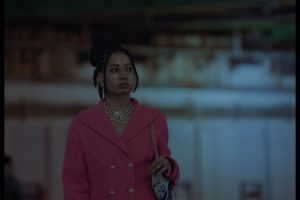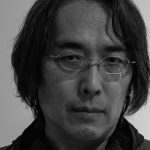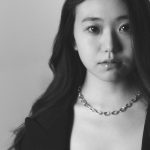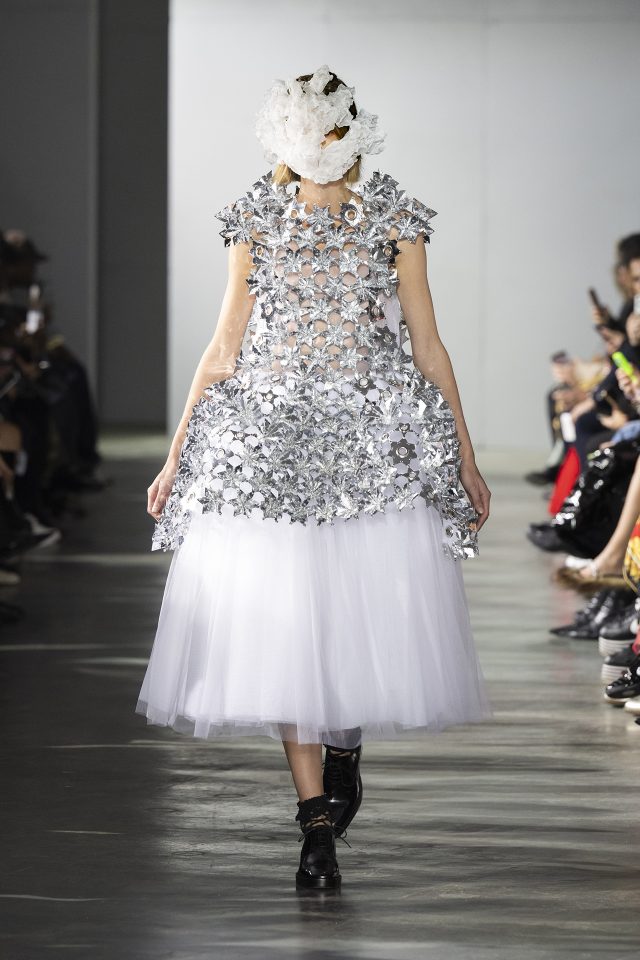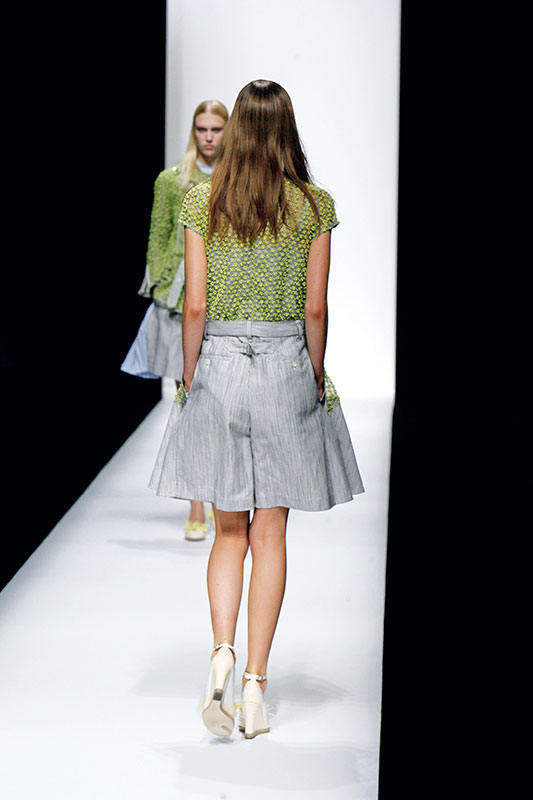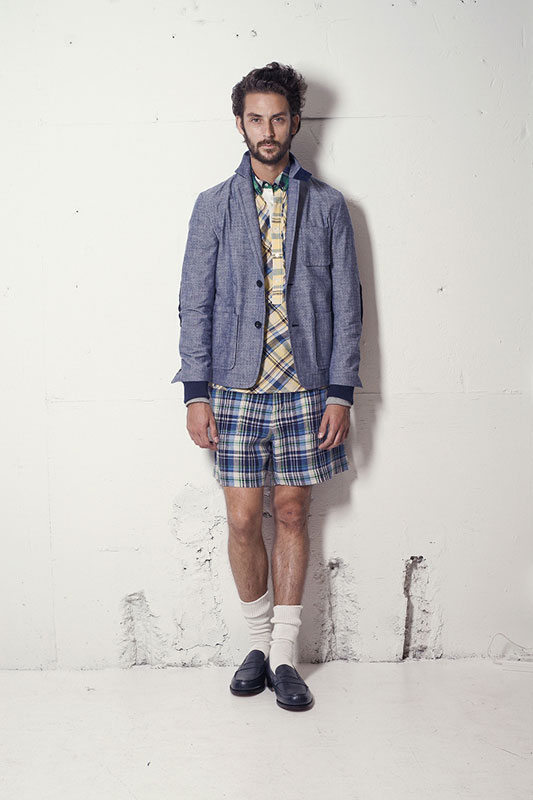クリエイティブディレクター・源馬大輔インタビュー
Daisuke Gemma
いまをときめくファッションブランド sacai (サカイ) のクリエイティブ・ディレクションをはじめ、香港の高級百貨店 Lane Crawford (レーン・クロフォード)のバイイングなど、世界的に注目を受ける国内外のブランド・ショップの仕事を手がける源馬大輔氏。仕事の幅は広く、コンサルティングからマーケティング、商品開発、そして内装ディレクションまで及ぶ。20 代前半よりロンドンのハイエンドなセレクトショップ BROWNS (ブラウンズ) でキャリアを積み、 2002 年の帰国以降は、中目黒のセレクトショップ Family (ファミリー) の立ち上げや、アタッシュ・ド・プレスの Pred.PR (プレッドピーアール) を設立させた。ドメスティックとインターナショナルの両方の視点を持つ源馬氏に、グローバルで成功するためのヒントを探った。
クリエイティブディレクター・源馬大輔インタビュー
Portraits
*You’ll find the English text after the Japanese.

Photo by Hidemasa Miyake | © The Fashion Post
いまをときめくファッションブランド sacai (サカイ) のクリエイティブ・ディレクションをはじめ、香港の高級百貨店 Lane Crawford (レーン・クロフォード)のバイイングなど、世界的に注目を受ける国内外のブランド・ショップの仕事を手がける源馬大輔氏。仕事の幅は広く、コンサルティングからマーケティング、商品開発、そして内装ディレクションまで及ぶ。20 代前半よりロンドンのハイエンドなセレクトショップ BROWNS (ブラウンズ) でキャリアを積み、 2002 年の帰国以降は、中目黒のセレクトショップ Family (ファミリー) の立ち上げや、アタッシュ・ド・プレスの Pred.PR (プレッドピーアール) を設立させた。ドメスティックとインターナショナルの両方の視点を持つ源馬氏に、グローバルで成功するためのヒントを探った。
—最初に源馬さんのバックグラウンドと、いまやられている仕事について教えてください。1996年に渡英されたとのことですが。
当時、目指していたことはあったのですが、うまくいかなくて、父親に「どっか行ってくれば?」と言われたのがキッカケでロンドンに行きました。はじめは半年間くらいで帰る予定だったので、みんなのようにセントマーチンに行って勉強したいという感じではありませんでしたけど。なので、とくに働くつもりもなかったです。たまたまそのころ、BROWNS (ブラウンズ) によく買い物に行っていたのですが、当時 BROWNS のメンズのバイヤーをやっていた Bernie Thomas (バーニー・トーマス) と仲良くなりました。当時の僕の英語は本当につたなかったのですが、「働けば?」と言ってくれて、働くようになりました。22 歳になる年に、いきなり「バイイング行ってこいよ」と言われて、Bernie と一緒に買い付けに行くようになりました。英国では年齢はあまり関係ないのでしょうね。気付いたら 6 年も経っていました。いまでも彼とは仲良く一緒に仕事をしています。ロンドンでいろんなことを体験できたことは本当に良かったです。当時、さまざまな文化に触れられたし、友達がいろいろな人を紹介してくれました。例えば、パブで普通に飲んでいて紹介されたのが Chris Cunningham (クリス・ カニンガム) 。「こんな所に Chris Cunningham が普通にいるのかよ!すごいなロンドン…」と思いました (笑) 。あと、普通にいつもパブで一緒に飲んでいた人が Tate Modern (テート・モダン) のロゴなどをデザインしている人で、 Tate Modern のオープニングに連れて行ってもらうと、そこに Damien Hirst (ダミアン・ハースト) がいたりもしました。当時の英国は景気もよく、アート、音楽、ファッションの分野でさまざまなことが起きている時代でした。Damien Hirst が出てきたり、White Cube (ホワイト・キューブ) というギャラリーができたり。「あのクラブがたのしかったよね」というのもあるのですが、なによりそういうおもしろい人たちに出会えたというのが一番大きかったですね。自分のそれまでの常識を覆す人たちがロンドンにはたくさんいて、僕の見解の狭さが分かったときはすごくショックでした。しかし、もっと自由にいろいろとやって良いのだと思えたのが、ロンドンで得た一番大きな収穫ですね。BROWNS では 6 年間働いたのですが、そこでそろそろ次のステップを考えていた頃に、日本の企業から「日本でお店をやってみない?」とお誘いいただきました。僕自身、日本でまだなにもやったことがなかったので、日本でやりたいという気持ちがあり、日本に帰ってきたという感じです。帰国後は自分のお店 Family をオープンさせ、Pred.PR を設立しました。そして 2007 年にいまの個人の会社「源馬大輔事務所」をスタートさせて、基本的にはコンサルティング業中心にファッションに関わる全てのことをやっています。クライアントには香港の Lane Crawford や JOYCE (ジョイス) などの小売店もあれば、日本のブランドの sacai もあります。あと最近はアジアからお話をいただくことも増えていますね。
—2002 年に日本に帰国されて、海外のファッション業界を経験している視点から見て、日本のファッション業界はどのようにうつりましたか?
マーケットがドメスティックだなと。日本国内の常識というのがあり、僕はそれにすごく疑問を感じていました。2002 年の 8 月に帰国したのですが、半年間くらいは、「なんで帰ってきちゃったんだろう…」とモチベーション的には下がっていました。
—帰国なさってから約 10 年が経ちますが、とくに変わったと感じるところはありますか?
変わったというより「こんなもんだな」という感じです。僕らの世代のせいもあると思いますが、昔のほうがファッションの世界に勢いがある人材が多かった気がします。いまは IT 業界とかにそういう人材が多いのかもしれないですね。 昔は洋服屋さんをやるにしても、ブランドを作るにしても、少しエッジの効いたモノを、きちんと大きいフィールドでやろうとしている人が多かった気がします。いまの若い人たちは、若い人たちだけでくっついてやる傾向がありますよね。尖っている人たちもいますが、その人たちがメジャーリーグではなく、草野球で満足してしまっている感じがします。もっとメジャーなところに出てきてやっても良いのにと僕は思うんでけどね。上昇志向があまりないかもしれません。
—いまはどれくらいの頻度で海外に行かれていますか?
去年は 12 回行きました。ヨーロッパはもちろん、米国も行きます。最近はアジアに行く機会も多くなりました。特に韓国。いま韓国はファッション業界を盛り上げようとしています。日本とは違うと思うのは、やはり向こうの人たちはやると決めたらそこに予算をしっかりと組んでやるところ。日本はなんとなくみんな平等にという考え方がありますよね。
—コンサルティングやバイイング、さらに内装のディレクションと、幅広いお仕事をなさっていますが、どうやってスキルを学んだのですか?
僕は興味のあることを仕事にしたいタイプ。前の会社ではお店をつくる機会が 多く、さらにインテリアが好きということもあり、内装をやらせてもらっていました。ノウハウはほとんど仕事をしながら、学ばせてもらう感じです。モノ作りもやったことはありませんでしたが、いろいろな人に教えてもらいながらやってきました。そういう意味では、自分を埋めていく作業が常にありますね。
—sacai はいま海外で評価されている数少ないの日本ブランドですけど、ずばり sacai の魅力とはなんでしょう?
sacai はとにかく「良いレシピだ」とよく言われます。とてもおもしろい表現ですよね。例えば sacai では、メンズのクラシックなセーターやジャケットを違うボリュームに変えたりしています。それを見た人が、とにかくそのレシピや 味付けが良いと言う。阿部千登勢さんには、女性ということもあり、自分が着るモノというのがまず前提にある。そのなかで常に新しいボリュームとか、女性にしか分からない部分を追求している。そして、阿部さんがやることにはすべて意味がある。ただかわいいからラッフルを付けるのではなく、意味があるからラッフルを付ける。なぜそのジャケットがそういう形に変形したのか、を理路整然と言葉にできるぐらい、全部に意味がある。そしてあらゆることにシビアです。お店の内装や、ショー会場にもひとつひとつ意味が求められる。それが sacai の強みだとおもいます。常に新しいことを目指し、みんなの期待に応えるのではなく、必ず裏切る要素も入れてきますし。
—いま海外に進出したい日本のブランドが多いと思うのですが、世界の舞台で活躍するにはなにが必要でしょうか?
やはり海外でやろうと思ったら、少し海外の常識を知る必要があると思います。 海外で評価されたいのなら、ある程度向こうの常識というものをくみ取らない とむずかしい。知らずに自分たちだけの理屈でやるというのはすごく大変なことです。もちろん日本人のスタッフも優秀ですけど、例えば sacai の場合、Karl Templer (カール・テンプラー) という人がスタイリングをやってくれています。彼は本当に洒落にならないくらいすごいです。仕事の詰め方もそうだし、彼にイメージを伝えるとすぐに理解してくれる。
—最近注目している国内外のデザイナーいますか?
White Mountaineering です。デザイナーの相澤陽介くんは、世代的には僕より年下ですけど、COMME des GARÇONS (コム デ ギャルソン) 出身ということもあり、海外で勝負するということを知っています。
—海外と比べて、日本のファッション産業はどうですか?
米国がすごいと思うのは、昔から「スターを作ろう」という明確なコンセプトがあるところです。Anna Wintour (アナ・ウィンター) たちが中心になって、スターにするためにお金を使う。Marc Jacobs (マーク・ジェイコブス) からはじまり、Thom Browne (トム・ブラウン)、いまでいうと Alexander Wang (アレキサンダー・ワン) はまさにそうです。もちろん彼は実力もあり、コミュニケーション能力もある。その上で、その後押しに乗って、いまの米国が狙っているマーケットに対して、しっかりと実力を発揮しています。個人的にはそういうことをもっと日本もやったら良いとおもっています。例えば、日本でも UNDERCOVER のジョニオくんや TAKAHIROMIYASHITATheSoloIst. (タカヒロミヤシタザソロイスト.) の宮下貴裕くんとかはスターですよね。Japan Fashion Week (JFW) のコミッティを少しやっていて分かったのですが、日本では予算の付け方など、すべてに対して平等にしようという傾向がある。そのため米国などと比べてスターが生まれにくい状況になっているとおもいます。もちろん実力がないとダメですが、力のあるのデザイナーをピックアップして大々的にプロモーションするのも良いかなと。でも日本では実力があるデザイナーでも匿名性を求めるケースが結構あったりしますよね。
—いま日本のファッション産業がかかえる課題に対して、源馬さんは今後どのような関わり方を考えていますか?
地球はどんどん小さくなってきているし、感覚的に近いような人たちがたくさんいるような時代になってきました。マーケットにおいても、日本やアジアのように変にくくらないで、グローバルに捉えていけると良いとおもいます。日本はなまじマーケットが大きいため、なにをやってもついついガラパゴス感が出てしまう。とくに日本のファッション業界が採用している値付けのシステムは日本特有で、海外ではまったく別のやり方がとられています。だから海外に 輸出したときに内外価格差がドンと出て売れないという現象が起きてしまっています。とくに韓国や香港は地理的に近いのですが、向こうで日本のブランドを購入しようとしたら、日本の 1.8 倍くらいの値段になってしまうケースもあります。そのため向こうの人たちはわざわざ日本に来て購入する。これは良くないですよね。そういう仕組み作りも含めて、グローバルな視点を持ち込めたらとおもっています。また、よく日本のカルチャーを台湾や韓国に発信しましょうというときに、わざと敷居を下げたりしますよね。そういうのを見るたびに、不安を感じてしまいます。台湾や韓国をなめすぎだとおもいますね。韓国の商業施設のアートなどは信じられないくらいレベルが高いです。なにより、やっている人たちがインターナショナルな人たちばかり。韓国は世界のスタンダードで勝負しようとしています。香港もそうですが、低いスタンダードというのは向こうには存在しないです。なので、アジアを後進国だと捉えたあのマーケティングというのは、ひとつも形になっていないとおもいますね。
—日本の若手デザイナーにおもうことはありますか?
若い子たちにはもっとインターナショナルで勝負したいとおもってもらいたいですね。サッカー選手も 20 代前半でもう世界で勝負していますし、ファッションだって勝負しても良いですよね。ロンドンにいると世界が近く感じられます。なぜならロンドンで起こっていることが実際に世界に発信されて、世界のスタンダードになるからです。だけど日本だけで盛り上がっていても、世界のスタンダードにはなりにくい。東京で起こっていることをスタンダードにしてしまうとその先の成長がない。sacai の阿部千登勢さんや kolor の阿部潤一さんにしても、COMME des GARÇONS みたいなグローバルで勝負をしている企業での経験を、うまくいまに繋げて成功していると思いますし、mame (マメ) の黒河内真衣子さんも、ISSEY MIYAKE (イッセイ ミヤケ) での経験が生きているのではないでしょうか。それに20 代、30 代というのはいろいろなコトを吸収できる年代です。僕はいま37歳ですが、この年齢になるとさすがにもう裸で飛び込むことができません。そういう意味でも若い子たちには、感受性豊かなことをやってほしいなとおもいます。
—最近気になるトレンドはありますか?
4月の下旬に発表される『Origami』というモバイルプラットホームがおもしろいと思います。実店舗とバーチャルの世界をうまく融合した仕組みです。いままではどうしてもeコマースとフィジカルなお店がうまくリンクしていなかったとおもうのですが、期待が持てるサービスです。そのコンテンツ自体が十分にかっこ良くないと残念なことですし、ファッション業界に関わる若い子も、彼らみたいな波に乗っていけると良いなとおもいます。
—東京のおすすめスポットを 3 つ教えてください。
代官山蔦屋書店 (だいかんやまつたやしょてん)
住所: 東京都渋谷区猿楽町 17-5
Tel: 03-3770-2525
海外からくる人たちはほとんど気に入ってくれます。海外の本屋さんも、ソファーがあってコーヒーを飲みながら本を読むというスタイルが多いですからね。
bonjour records (ボンジュール・レコード)
住所: 東京都渋谷区猿楽町 24-1
Tel: 03-5458-6020
コンテンツがインターナショナル・スタンダードです。ディレクターの上村真俊くんは、そこで起きているモノを紹介したいという意識が強いタイプだとおもいます。意外に知られていないですが、本のセレクションも結構良いです。
sacai (サカイ)
住所: 東京都港区南青山 5-4-44 南青山シティハウス A-1F, 2F
Tel: 03-6418-5977
すばらしいお店です。sacai のすべてのラインが観られます。
<プロフィール>
源馬大輔 (げんまだいすけ)
クリエイティブ・ディレクター。1975年生まれ。1996年に渡英し、1997年にロンドンの BROWNS 社に入社。バイヤーとしてのキャリアをスタートさせる。2002年帰国後、中目黒にセレクトショップ FAMILY を立ち上げ、 WR/Family Executive Director に就任。2007年に独立し、源馬大輔事務所を設立。CELUX(LVJグループ)のブランディング・ディレクターなどを務め、現在は sacai のクリエイティブ・ディレクションや香港の高級百貨店 LANE CRAWFORD のバイイング・コンサルタントなどを担当。マーケティングから商品開発、内装までディレクションし、日本だけでなく海外との契約も多数。
Daisuke Gemma is currently working as Creative Director for the thriving fashion brand, sacai. He also handles the buying for the Hong Kong department store, Lane Crawford. He works with brands both inside and outside Japan which are gaining attention worldwide. Gemma has a wide range of skills and he works with marketing, consulting, product development, and even interior design. His career started in his early twenties when he began working at the London select shop, Browns. After his return to Japan, he launched the Nakameguro select shop, Family, and also established Pred. PR, part of Attache de Press. With both domestic and international business in mind, The Fashion Post went to Gemma for his secrets to global success.
—First, please tell us about your background and what sort of job you’re doing now. We understand that you went to England in 1996?
Back then, I was really trying to achieve something, but things weren’t going well. So my father said to me, “What if you went away?” That was the push which sent me to London. I’d originally meant to stay for only half a year, but I had no plans to go and study at Saint Martins like everyone else was doing. At the time, I happened to be shopping at Browns quite a bit and I’d got to know the menswear buyer, Bernie Thomas. My English skills were really terrible then, but when he asked me to work for them, I said yes. When I was 22 years old, I was told to go to the buying. From then on, I accompanied Bernie to the purchases.
In the United Kingdom, age really means nothing. Before I knew it, six years had passed. Even now, Bernie and I work together as close friends. It was really great to experience so much in London. At that time, I was touched by so many different cultures and introduced to so many different people by my friends. One time, I was drinking at a pub when I was introduced to Chris Cunningham. I thought, “Wow! Chris Cunningham is just at a bar like this?” Another time, one of my usual drinking partners who designed logos for the Tate Modern took me to the gallery opening. Damien Hirst was there. The economic state in the United Kingdom was good then and there were many events taking place in art, music and fashion. Damien Hirst appeared and the White Cube gallery was established. I could talk about how fun the clubs were back then, but the biggest thing for me was all the interesting people I met. There were a lot of people in London who undermined what I knew up to that point. When I realized the narrowness of my own point of view, I was shocked. The biggest reward from London was deciding that it would be good to try more varied things in a freer manner.
I had worked at Browns for six years when I began thinking about my next step. Around this time, I received an invitation from a Japanese business. They asked me, “Would you like to start up a store in Japan?” I had no professional experience in Japan, but I wanted to work there even so. When I returned to Japan, I felt I had finally come home. I opened my own store, Family, and I established Pred. PR. In 2007, I started my own company, ‘Offices of Daisuke Gemma’ [‘Gemma Daisuke Jimusho’]. It mainly functions as a consulting company and handles everything connected to fashion. Hong Kong’s Lane Crawford and retail stores such as Joyce are part of the clientele, as well as the Japanese brand sacai. Now we are receiving more and more business offers from Asia.
—How did you feel about the Japanese fashion industry when you came back in 2002 after having experienced the industry abroad?
I felt that the Japanese market was only domestic. There is a common knowledge inside Japan and I had a lot of doubts about this. For nearly half a year after returning, I kept thinking, “Why did I come home?” I really lost a lot of motivation.
—It’s now been ten years since you came home. Is there anything you feel has changed?
I don’t think the Japanese fashion industry has changed much since then. It’s just how it is. I think that part of it is our generation’s fault, but I also feel that the older generation had more people with influence in the fashion industry. Now, there are probably more people in industries such as IT. I feel that, once, there were a lot of people who were putting items with a little edge to them out into a large field, whether they were making a brand or running a shop. Now young people don’t really try to go further. They’re happy with working with their friends only. There are refined people, but they aren’t playing in the major leagues. They’re happy playing in the sandpits, I feel. I think that they should get out and do more in the major leagues. There’s probably no real aim to improve or advance.
—How often do you go abroad these days?
Last year, I went abroad twelve times. I go to Europe, of course, but I also go to America. Recently, I have also been going to Asia a lot, especially Korea. Korea is really trying to stir up the fashion industry. I think that the difference between Japan and South Korea is that, in South Korea when they decide to do something, they do it firmly with a sufficient budget. In Japan, people tend to assume that everything should be given an equal part of the budget.
—You’re doing many different jobs such as consulting, buying and interior design directing. How did you learn your skills?
I’m the type of person who likes to do what they’re interested in. At my last company, there were many opportunities to open stores. I liked interior design and so I was allowed to design. Much of the know-how was learned while I was on the job. I didn’t know how to make things, but I was taught by various people over time and I have since learned how to do it. That also means there’s a job for one to do.
—There aren’t many overseas reviews of sacai at the moment. What is sacai’s appeal?
Well, firstly, sacai is said to have a “good recipe”. That’s a really interesting way of putting it. For example, sacai might take a classic men’s sweater or jacket. They then change it and add a different volume. The people looking at this say that the piece now has a good recipe or a good flavor. For Chitose Abe, femininity and clothes that you can wear yourself are prerequisites. Within those, Chitose Abe is seeking to add new volume to things and with aspects only a girl would understand. There is a meaning inside everything she does. Instead of simply adding ruffles because they’re cute, she adds ruffles because she has a particular reason. If she was asked why she’d made a jacket in a certain way, she could explain her thought process logically in words. There is a meaning in everything and there is also a severity in everything. In the store’s design or in the show space, a meaning is demanded. I think that is the strength of sacai. They are always aiming for something new, and instead of simply giving everyone what they want, there is always an item that goes against that grain.
—There are a lot of Japanese brands that want to expand abroad. What do you think they need to do to be successful on the world stage?
If you want to expand abroad, it is naturally important to understand the common practices of those countries. Being popular abroad will be difficult if you can’t understand the common knowledge and social etiquette of those countries. It’s extremely difficult to go by just your own understanding. Of course, the Japanese staff are great, but you’d need to work with people who know much more about European and American fashion markets. At sacai, Karl Templer does the styling. He’s so good, like seriously good. His work ethic is amazing, and if you convey an image to him, he understands perfectly.
—Are there any designers you’re noticing inside and outside Japan?
White Mountaineering. The designer, Yosuke Aizawa, is younger than me, yet he comes from Comme des Garcons and knows how to be successful abroad.
—How is the Japanese fashion industry doing in comparison to the foreign markets?
What I think is amazing about America is that, for a long time, there has been a clear concept of creating stars. With Anna Wintour and others at the center, money is used to create big names. Marc Jacobs, Thom Browne and now Alexander Wang are good examples of this. Of course, Alexander Wang has his strengths and good communication skills. In regards to the market that America is aiming at, these individuals are strongly displaying their abilities.
In Japan, it wouldn’t be bad to do more of that individually. For example, Undercover’s Junio or TAKAHIROMIYASHITA TheSoloIst’s Takahiro Miyashita are stars, right? I understood this after working on the Fashion Week committee, but in Japan, the distribution of the budget seems to be spread out evenly. That’s why I think it’s harder to create stars here than it is in America. Of course, if people don’t have the talent, it’s impossible. I just feel that it would be good to support the designers with true strength and promote them in a big way. That said, in Japan, there are a lot of cases where the designers wish to remain anonymous.
—Bearing in mind the Japanese fashion industry’s current problems, what kind of interactions do you think you will have from now?
The world is getting smaller and smaller. This is an era where there seem to be many people with the same sensibilities. In terms of fashion markets, I believe it’s best to think globally rather than to separate Japan or Asia from the rest of the world. The Japanese fashion market is so big that things can go well despite what is relevant in other markets. For example, the pricing system employed in Japan is completely different to that of other countries. When products are exported overseas, there’s such a great difference in the prices that the pieces can’t be sold. Although Hong Kong and Korea are so close geographically, when Japanese products are purchased in those countries, the prices go up by 1.8 times that of Japan. As a result, people from those areas come all the way to Japan to buy Japanese products. This is not good. When making these plans, I think it would be useful to consider the foreign point of view. Also, whenever Japanese culture is transferred to Korea or Taiwan, the threshold is always purposely lowered. Whenever I see this happen, I feel worried. I think it puts Taiwan and Korea down too much. The Korean art business establishment is operating at such a high level, I can hardly believe it. More than anything, the people running it are all internationalized. Korea is competing on an international standard. Hong Kong is the same, but there is no such thing as a low-level over there. There’s no point in seeing Asia as underdeveloped in terms of marketing.
—What do you think of the current young Japanese designers?
I want young people to aspire to compete abroad. Soccer players are competing on a world level in their early twenties, so I think it would be good for fashion to do the same. When you’re in London, the world feels much closer. This is because everything that happens in London is broadcast to the world and this becomes the world standard. However, if something only becomes big in Japan, it doesn’t usually become the world standard. If you make what happens in Tokyo the standard, then there is no growth beyond that because that’s not going to be the world standard. Sacai’s Chitose Abe and kolor’s Junichi Abe, for example, are successful due to their experience with global businesses such as Comme Des Garcons. Maiko Kurogouchi is also using her experience at Issey Miyake very well. You can learn many different things in one’s twenties and thirties. I am 37 now, but as expected, when you turn this age, you can no longer jump in naked. With that, I want young kids to do things with extreme sensitivity.
—Are there any trends that you’re into these days?
I think the mobile platform ‘Origmai’ is interesting. Its structure is a good merging of the virtual world and actual stores. I think that, until now, e-commerce and physical stores have not been linked well. There are a lot of expectations for this service and it will be regrettable if the contents aren’t that good. I think young kids connected to the fashion industry should ride a wave like the people at origami are doing.
—Please recommend three Tokyo spots for us.
Daikanyama Tsutaya Bookstore.
Address: Tokyo-to, Shibuya-ku, Sarugakuchou 17-5
Foreigners really appreciate this store. This is because most bookstores abroad have sofas and coffee available to you while you read.
Bonjour Records
Address: Tokyo-to, Shibuya-ku, Sarukakuchou 24-1
This store’s contents are of an international standard. I think the director, Masatoshi Uemura, is the type of person who wants to introduce what’s happening abroad. Surprisingly, not so many people are aware how good the selection of books is here.
Sacai
Address: Tokyo-to, Minato-ku, Minamiaoyama 5-4-44 Minamiaoyama City House A-1F, 2F Tokyo 107-0062 Japan
Tel: 81-3-6418-5977
This is a really rare store. The entire Sacai line is on display.
<Profile>
Daisuke Gemma
Creative director / Born in 1975. Daisuke moved to England in 1996. He worked as a buyer for Browns in London. After returning to Japan, he established FAMILY, (select shop), and served as an executive director. Daisuke became independent in 2007. His clients has included CELUX (LVJ Group), and Branding Director. He now closely works with sacai, and LANE CRAWFORD in Hong Kong. Daisuke can manage projects ranging from product development to interior decoration. He also has experience with a number of foreign contracts.
